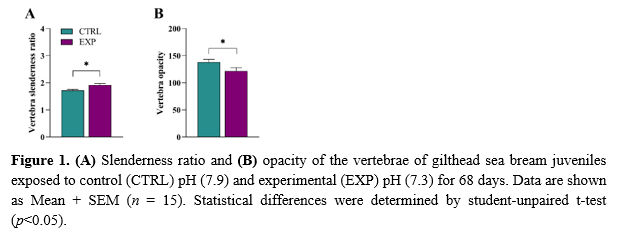EFFECTS OF OCEAN ACIDIFICATION ON GROWTH AND MINERALIZATION OF SKELETAL STRUCTURES IN GILTHEAD SEA BREAM Sparus aurata
Introduction
The increase in anthropogenic carbon dioxide (CO2) emissions results in a decrease in oceanic pH, a phenomenon known as ocean acidification (OA), which represents a considerable risk to the future of aquaculture. In marine invertebrates, OA reduces survival, growth, and calcification. In fish, elevated CO₂ levels in water have also been associated with reduced survival, specific growth rate (SGR) and protein biosynthesis, as well as alterations in behavior and reproduction (Heuer and Grosell, 2014). Contrarily, OA has been reported to enhance otoliths growth and calcification, as well as to modify their shape and composition, possibly due to efficient plasma pH compensation mechanisms. In fish with cellular bone, changes in bone mineralization under hypercapnic conditions have also been reported (Drábiková et al., 2023; Gil Martens et al., 2006). Furthermore, in vitro studies in mammals have demonstrated that osteoblasts activity is significantly affected by low pH conditions. However, the impact of CO₂ on fish with acellular bone mineralization remains less understood. The aim of this study is to assess the potential effects of OA on the skeleton in gilthead sea bream juveniles, using both in vivo/in vitro approaches.
Material and methods
Gilthead sea bream juveniles provided by the commercial hatchery Piscimar (Burriana, Spain) were maintained in the animal facilities at the Faculty of Biology at the University of Barcelona (Spain). After an acclimation period, animals were weighed and randomly distributed in two experimental groups exposed to different pH conditions: a control group maintained at pH 7.9, and a low pH group maintained at pH 7.3 by CO2 injection through a glass diffusor connected to a CO2 bottle. After 68 days of exposure, fish were measured and weighed, and 15 fish per condition were sampled. Blood was collected to determine hematocrit levels and plasma composition. Otoliths, gills and vertebral bone were carefully extracted and immediately frozen in liquid nitrogen. Bone mineral composition and mineralization by X-ray, remodeling and mineralization-related genes expression, as well as ion transport gene transcription in gills, were analyzed. Furthermore, primary cultures of gilthead sea bream bone-derived cells were performed. Then, cell viability and mineralization were assessed on cells cultivated under three different conditions, 2.5%, 1.5%, or 0% CO2, corresponding to a pH value of 7.79 ± 0.04, 7.49 ± 0.01, and 7.38 ± 0.02, respectively.
Results and discussion
No significant differences were observed in body weight or body length at the end of the experimental period. However, the SGR values were significantly lower in the experimental group compared to the control group, consistent with findings in European sea bass (Dicentrarchus labrax) (Alves et al., 2020). Plasma analysis revealed significantly higher pH and potassium levels in the experimental group, while ionic calcium, magnesium, and phosphorous levels remained unaltered, in agreement with previous studies (Alves et al., 2020; Costa et al., 2022). Bone mineral composition did not show significant differences between groups for any of the ions evaluated. However, X-ray analysis indicated an increase in vertebra slenderness ratio and a reduction in opacity in the experimental group (Figure 1). This suggests that, despite being less mineralized than in the control group at this time, the vertebrae of animals exposed to low pH appear to have undergone more longitudinal growth and could potentially reach higher mineralization levels if given a longer growth period. Otoliths from fish exposed to low pH exhibited a generalized increase in size, with a significant increase in most of the parameters determined compared to the control pH group. No significant differences were identified in the transcription levels of gills ion transporters between groups. Nevertheless, the low pH condition significantly upregulated the expression of the osteoblast marker, alkaline phosphatase (alp), and the osteoclast-related gene, matrix metalloproteinase-9 (mmp9), suggesting increased bone turnover in the experimental fish. In the in vitro experiments, the percentage of CO2 had a significant effect on both cell viability and mineralization, with the highest values for those parameters observed under the 0% CO2 condition after 30 days. Overall, the results of the present study provide new evidence of how climate change, particularly OA, can impact the skeletal structures of gilthead sea bream, an important species for both Mediterranean ecosystems and aquaculture industries.
References
Alves, A., Gregório, S.F., Ruiz-Jarabo, I., Fuentes, J., 2020. Intestinal response to ocean acidification in the European sea bass (Dicentrarchus labrax). Comp. Biochem. Physiol. Part A Mol. Integr. Physiol. 250, 110789.
Costa, R.A., Olvera, A., Power, D.M., Velez, Z., 2022. Ocean acidification affects the expression of neuroplasticity and neuromodulation markers in seabream. Biol. Open 11.
Drábiková, L., Fjelldal, P.G., Yousaf, M.N., Morken, T., De Clercq, A., McGurk, C., Witten, P.E., 2023. Elevated Water CO2 Can Prevent Dietary-Induced Osteomalacia in Post-Smolt Atlantic Salmon (Salmo salar, L.). Biomolecules 2023, 13, 663.
Gil Martens, L., Witten, P.E., Fivelstad, S., Huysseune, A., Sævareid, B., Vikeså, V., Obach, A., 2006. Impact of high water carbon dioxide levels on Atlantic salmon smolts (Salmo salar L.): Effects on fish performance, vertebrae composition and structure. Aquaculture 261, 80–88.
Heuer, R.M., Grosell, M., 2014. Physiological impacts of elevated carbon dioxide and ocean acidification on fish. Am. J. Physiol. - Regul. Integr. Comp. Physiol. 307, R1061–R1084, 2014.
Acknowledgements
Supported by the research project ACUISOST funded by MAPA and the European Union Next Generation EU/PRTR and the project PID2020-116172RB-I00 from the MICIU/AEI/10.13039/501100011033. IR was supported by a fellowship (PRE2021-100391) from the MICIU/AEI and by ESF Investing in your future.
